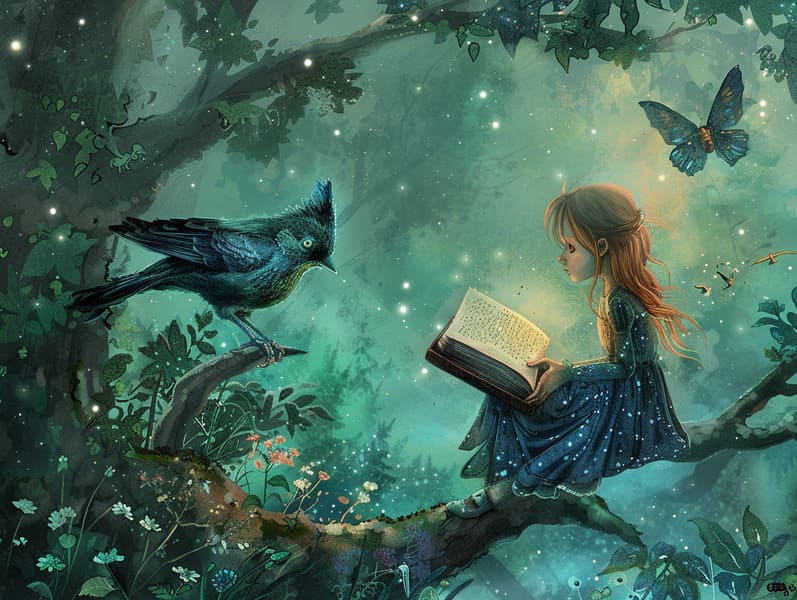
Grimm's fairy tales have ancient roots. These tales have been spoken from one generation to the next well before they were ever published. They were born from a variety of societies, including Western traditions. They were initially told among adults, often carrying themes and messages reflective of the societal norms and beliefs of the time.
Jacob and Wilhelm Grimm, the two Grimm brothers, were among the first to gather many of these beloved stories. Their volume, "Grimm's Children's Stories," included tales like "The Story of Cinderella," "Little Brother and Little Sister," and "The True Story of Snow White," which have since become cornerstones in the world of traditional fairy tales. Similarly, Andersen's imaginative tales, such as "The Little Mermaid," and "The Story of the Ugly Duckling," have enchanted hearts worldwide, securing their place in the pantheon of timeless fairy tales.
Though they are centuries old, fairy tales remain as applicable as ever, especially as children's night stories. These fantastical tales are now available in different formats, including beautifully illustrated books, enchanting animations, and online storybooks.
Their continued relevance can be ascribed to several delightful features:
Life Lessons: Old fairy tales often offer important moral lessons. Stories like "The Story of the Boy Who Cried Wolf" teach the importance of honesty, while "The Story of the Tortoise and the Hare" exemplify the values of perseverance and humbleness. These stories offer the young clear distinctions between correct and incorrect, guiding their moral compass in a kind yet important way.
Compassion and Insight: Old fairy tales frequently illustrate heroes facing tests and troubles, encouraging readers to identify with their struggles and rally behind their triumphs. For instance, "The Story of Beauty and the Beast" conveys the necessity of looking past the exterior to acknowledge the true essence of a being, nurturing understanding and insight.
Cultural Perception: Many fairy tales are interwoven with the cultural contexts from which they were born. Reading these narratives can provide enlightening views into different backgrounds, encouraging a sense of world insight and understanding.
Inventiveness and Fantasy: The enchanted elements in traditional fairy tales—enchanted objects—encourage children’s dreams. These narratives move readers to otherworldly realms, enhancing imaginative ideas and a sense of wonder that stays a lifetime.
Old fairy tales are not only enchanting but these guys also teaching. They provide captivating tools in strengthening various mind and heart abilities in kids. When fairy tales are told out loud, they improve verbal development by introducing new word meanings and complicated sentence structures. This practice also promotes hearing perception and concentration, as the young keep up with the story, ready to see what happens next.
Furthermore, discussing the themes and characters of fairy tales can advance intellectual skills and logical thinking. Little ones learn to find patterns, anticipate outcomes, and get cause and effect. These explorations also advance young readers reveal their thoughts and feelings, fostering their emotional intelligence.
In today’s information age, the abundance of online storybooks has made these fairy tales more acquirable than ever. Internet sites and online apps provide broad selections of classic fairy tales that can be browsed or listened on anytime, anywhere. Fairy tales recited are particularly favored, extending an interactive method for young readers to relish these entrancing tales. Read-aloud stories and narrated videos transport characters and settings to life, often accompanied by charming music and musical scores that boost the story adventure.
The timeless charm of old fairy tales lies in their ability to adjust to today's society while keeping their central messages. Contemporary takes of these stories often show more different protagonists and modern settings, making them pertinent to today’s audience. However, the key lessons of gallantry, sympathy, and even-handedness remain unchanged, continuing to connect with audiences of all ages.
Classic fairy tales also offer a sense of peace and knownness. They introduce a well-arranged narrative with a straightforward beginning, middle, and end, often coming to a close with the resolution of conflicts and the triumph of virtue over wickedness. This consistency can be heartening for young ones, showcasing a sense of unchangeability in an dynamic world.
Classic fairy tales continue to enchant and guide new generations, maintaining their enchantment and relevance in modern society. As nighttime stories for kids, they afford a perfect blend of charm and enlightenment, advancing moral values, empathy, and creativity. The abundance of internet fairy tales and the favor of fairy tales recited warrant that these ancient narratives remain within reach to new generations.
By guarding and communicating these stories, we continue to revere the rich tapestry of fables and cultural heritage. Whether you are seeing a vividly illustrated book, experiencing a electronic collection, or listening through an spoken story, the loveliness of bedtime fairy tales is always within reach. These tales remind us of the unending nature of tales and its ability to draw us together across eras and regions.
Whether you are perusing a colorful picture book, discovering a web-based library, or listening via an sound book, the wonder of traditional fairy tales is always within reach.
These fairy tales teach us of the unending essence of stories and its ability to connect us across centuries and lands, weaving a spell that fascinates and enlightens alike.
Comments on “Tracing the Heritage of Grimm's Fairy Tales and the Ageless Grandeur.”